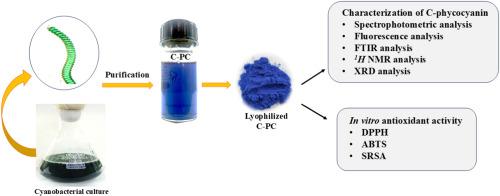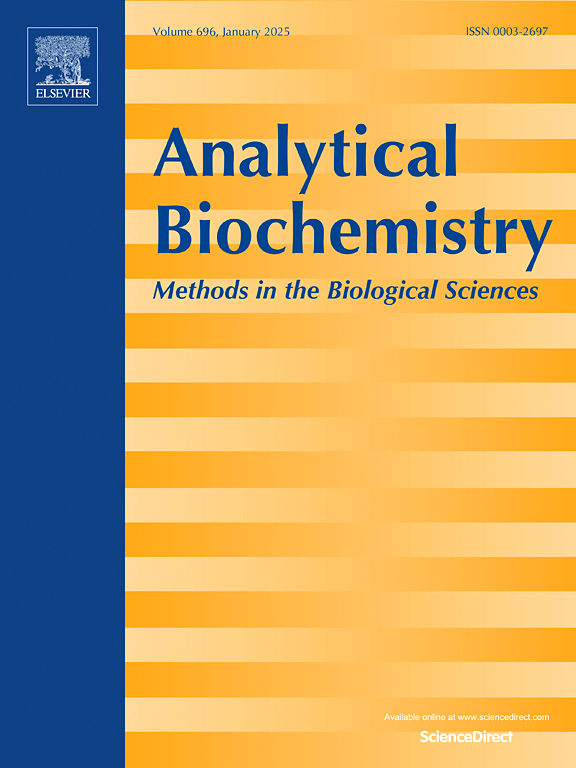Characterization and in vitro antioxidant activity of C-phycocyanin from the cyanobacterium Spirulina subsalsa HKAR-19
IF 2.5
4区 生物学
Q2 BIOCHEMICAL RESEARCH METHODS
引用次数: 0
Abstract
C-phycocyanin is a natural blue-colored pigment-protein complex existing as phycobiliprotein in cyanobacteria. C-phycocyanin is made up of two different subunits of α- and -β monomers. These subunits assemble to form a cylindrical structure known as phycocyanobilin chromophore. In the present study, C-phycocyanin was purified from the cyanobacterium Spirulina subsalsa HKAR-19 using ammonium sulfate precipitation followed by sucrose density gradient ultracentrifugation methods and characterized by various spectroscopic techniques. The purified C-phycocyanin showed an absorption peak at 615 nm. A characteristic fluorescence emission peak at 642 nm when excited over 615 nm, indicates the integrity and functionality of protein structure. The scavenging activity against free radicals of DPPH, ABTS, and superoxide (O2·−) was evaluated by using free radical scavenging assays. C-phycocyanin showed dose-dependent in vitro antioxidative properties towards free radicals. It possesses higher antioxidant activity toward ABTS•+ and DPPH•. Due to its high antioxidant activity, it can be used as a colorant and therapeutic agent against oxidative stress.

下螺旋藻HKAR-19中c -藻蓝蛋白的表征及体外抗氧化活性研究
c -藻蓝蛋白是一种天然的蓝色色素蛋白复合物,以藻胆蛋白的形式存在于蓝藻细菌中。c -藻蓝蛋白由α-和-β单体的两个不同亚基组成。这些亚基组合形成一个圆柱形结构,称为藻蓝胆素发色团。本研究采用硫酸铵沉淀-蔗糖密度梯度超离心的方法从藻蓝杆菌下螺旋藻HKAR-19中纯化出c -藻蓝蛋白,并用各种光谱技术对其进行了表征。纯化后的c -藻蓝蛋白在615 nm处有吸收峰。在615 nm以上激发时,在642 nm处有一个特征荧光发射峰,表明蛋白质结构的完整性和功能性。通过自由基清除试验评估其对DPPH、ABTS和超氧化物(O2·−)自由基的清除活性。c -藻蓝蛋白对自由基的体外抗氧化性能表现出剂量依赖性。对ABTS•+和DPPH•具有较高的抗氧化活性。由于其高抗氧化活性,它可以用作着色剂和抗氧化应激治疗剂。
本文章由计算机程序翻译,如有差异,请以英文原文为准。
求助全文
约1分钟内获得全文
求助全文
来源期刊

Analytical biochemistry
生物-分析化学
CiteScore
5.70
自引率
0.00%
发文量
283
审稿时长
44 days
期刊介绍:
The journal''s title Analytical Biochemistry: Methods in the Biological Sciences declares its broad scope: methods for the basic biological sciences that include biochemistry, molecular genetics, cell biology, proteomics, immunology, bioinformatics and wherever the frontiers of research take the field.
The emphasis is on methods from the strictly analytical to the more preparative that would include novel approaches to protein purification as well as improvements in cell and organ culture. The actual techniques are equally inclusive ranging from aptamers to zymology.
The journal has been particularly active in:
-Analytical techniques for biological molecules-
Aptamer selection and utilization-
Biosensors-
Chromatography-
Cloning, sequencing and mutagenesis-
Electrochemical methods-
Electrophoresis-
Enzyme characterization methods-
Immunological approaches-
Mass spectrometry of proteins and nucleic acids-
Metabolomics-
Nano level techniques-
Optical spectroscopy in all its forms.
The journal is reluctant to include most drug and strictly clinical studies as there are more suitable publication platforms for these types of papers.
 求助内容:
求助内容: 应助结果提醒方式:
应助结果提醒方式:


